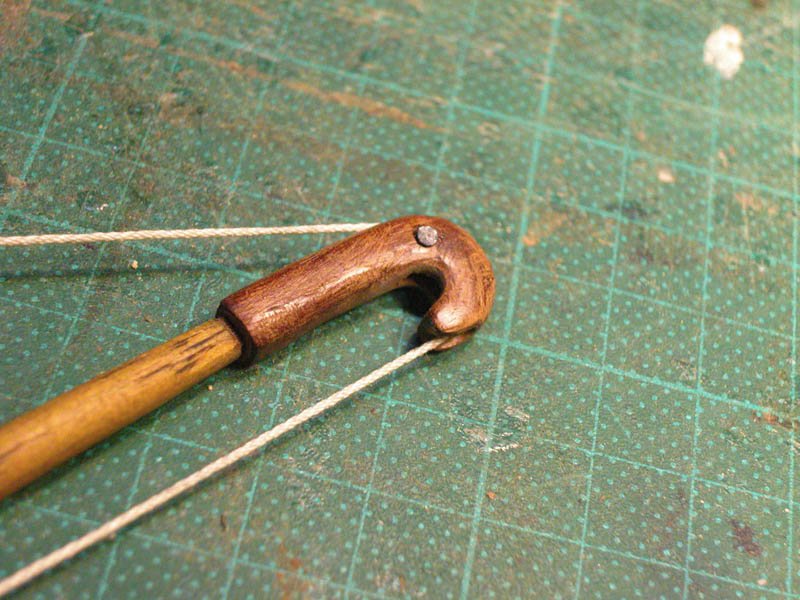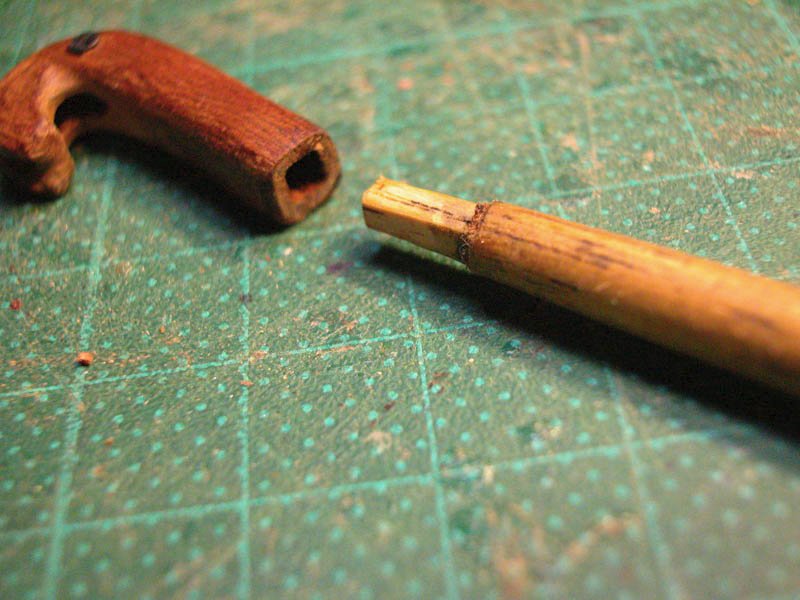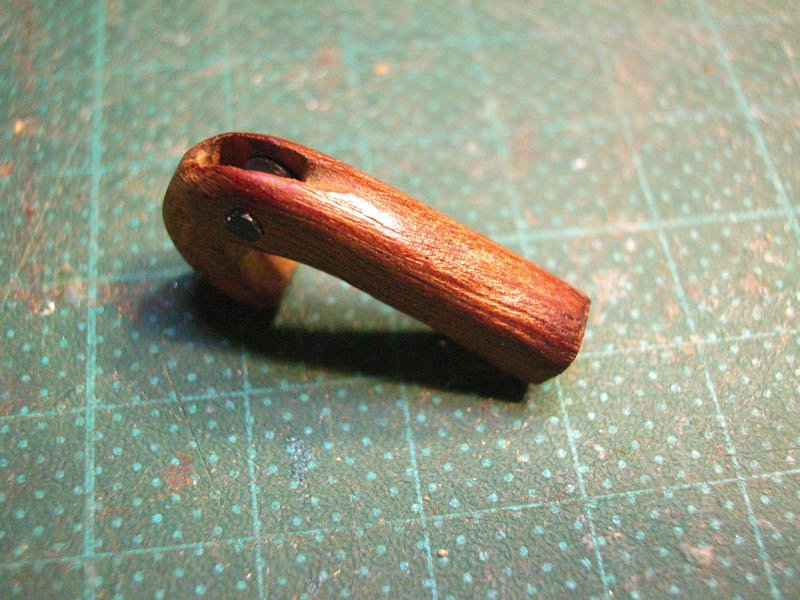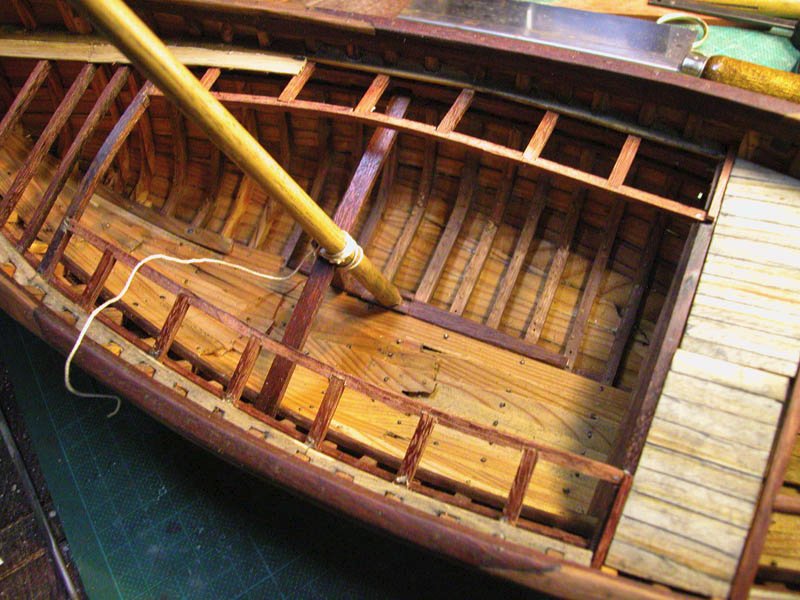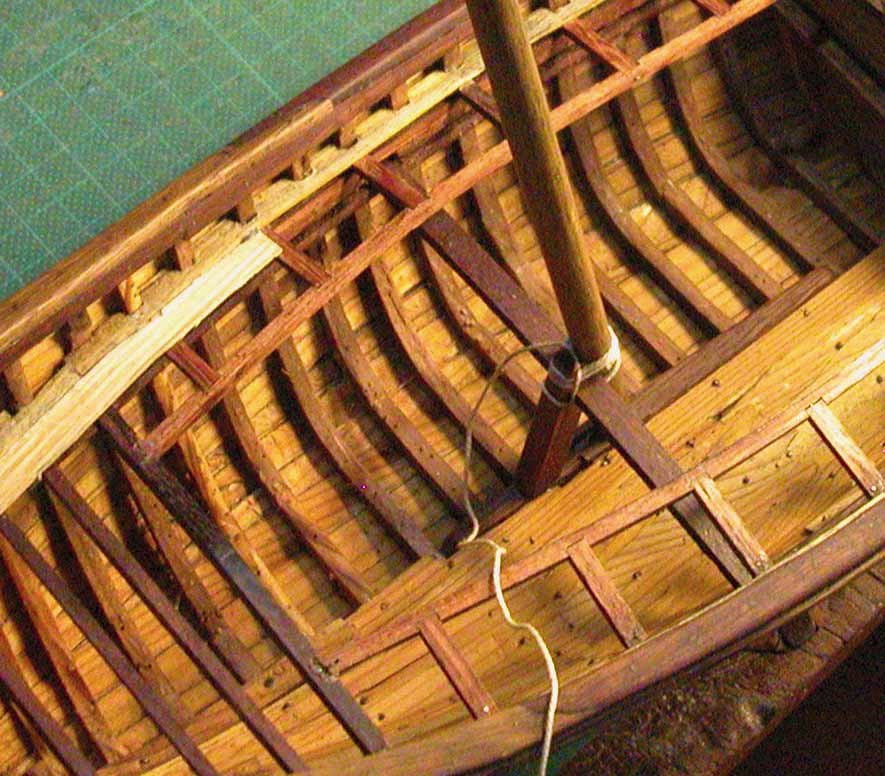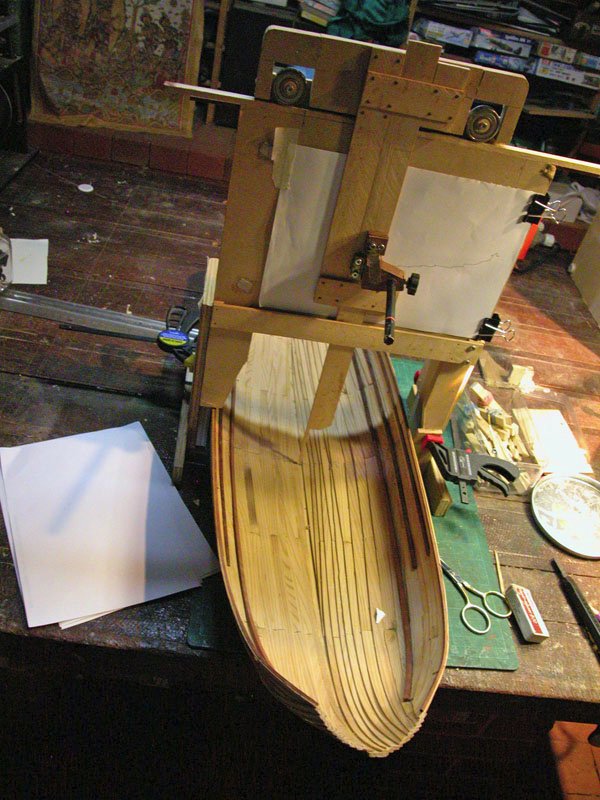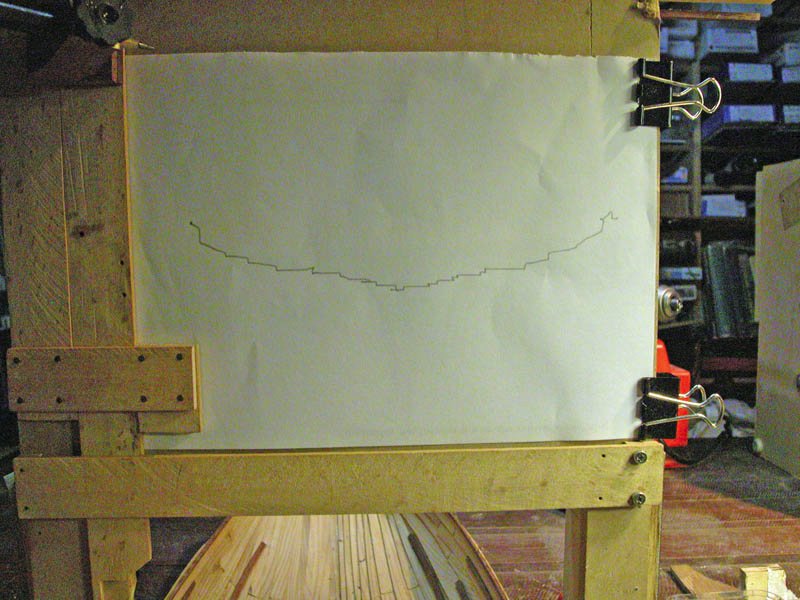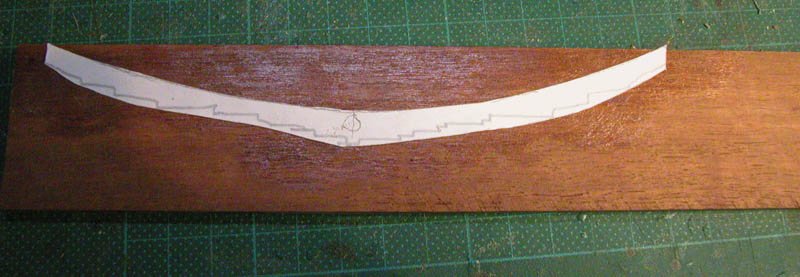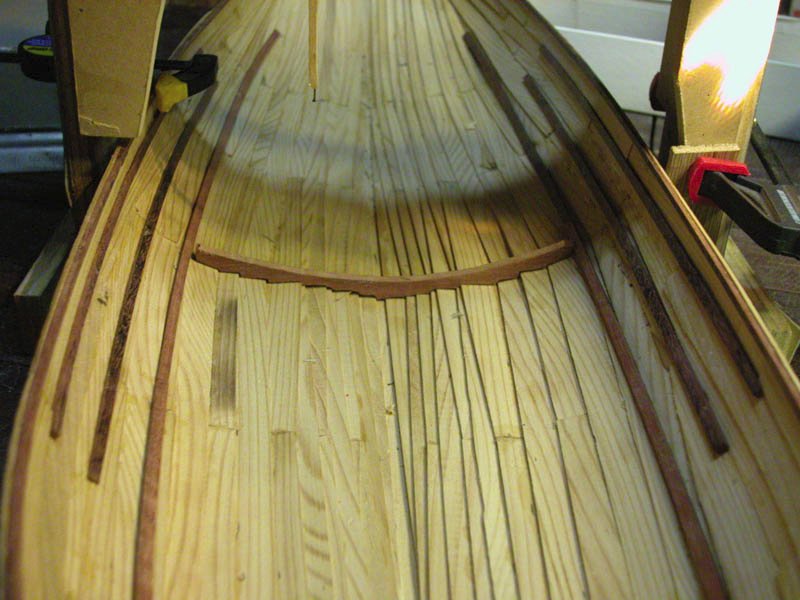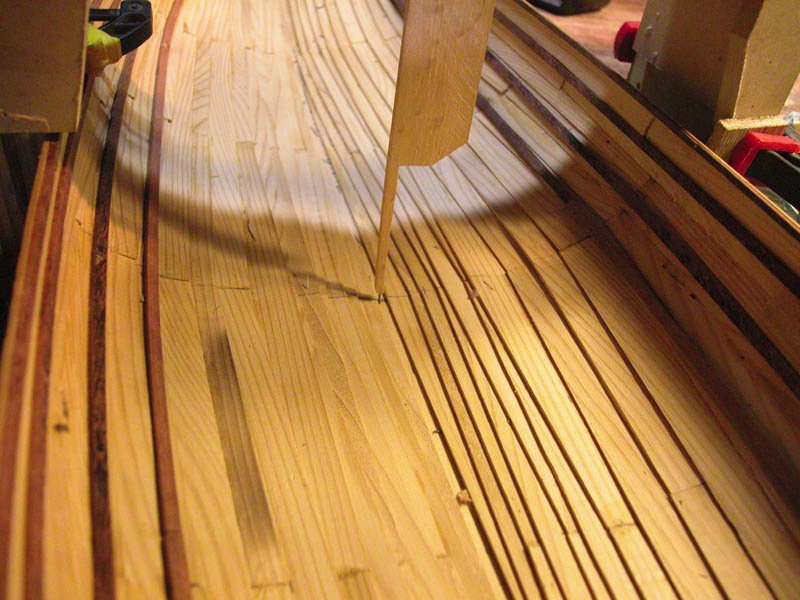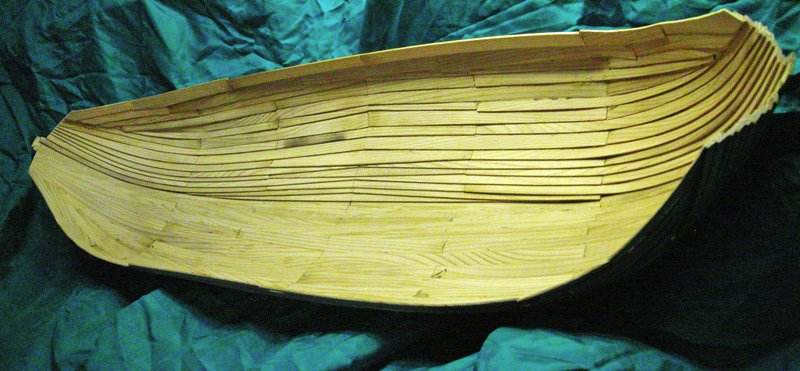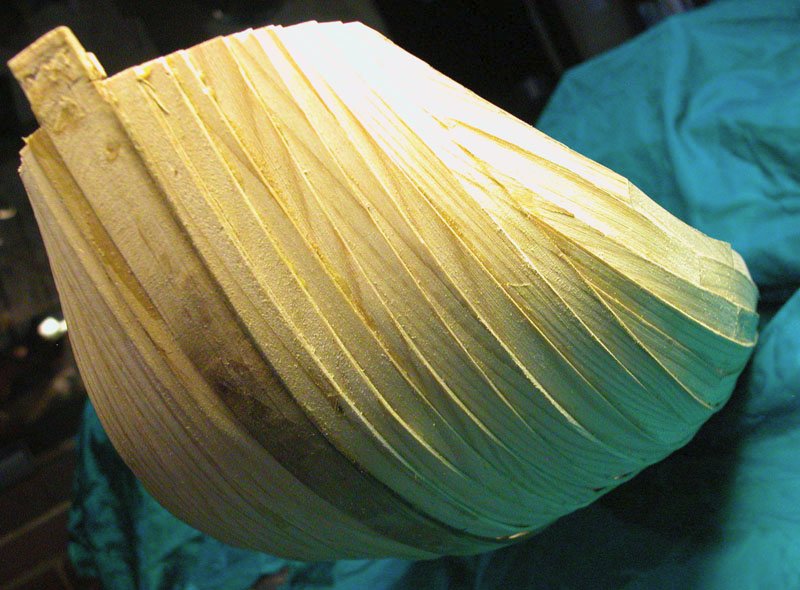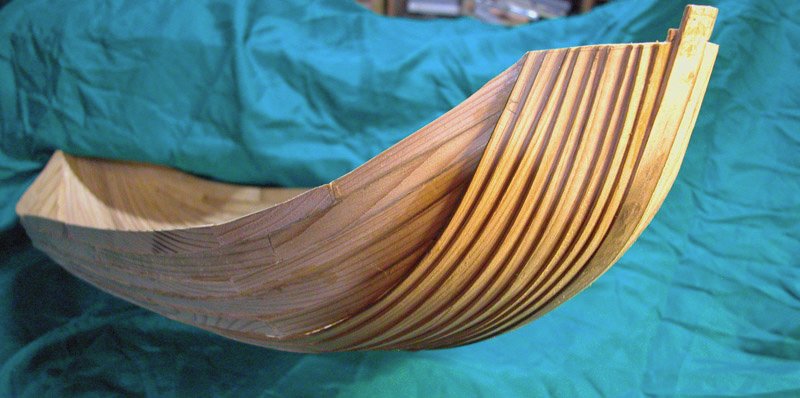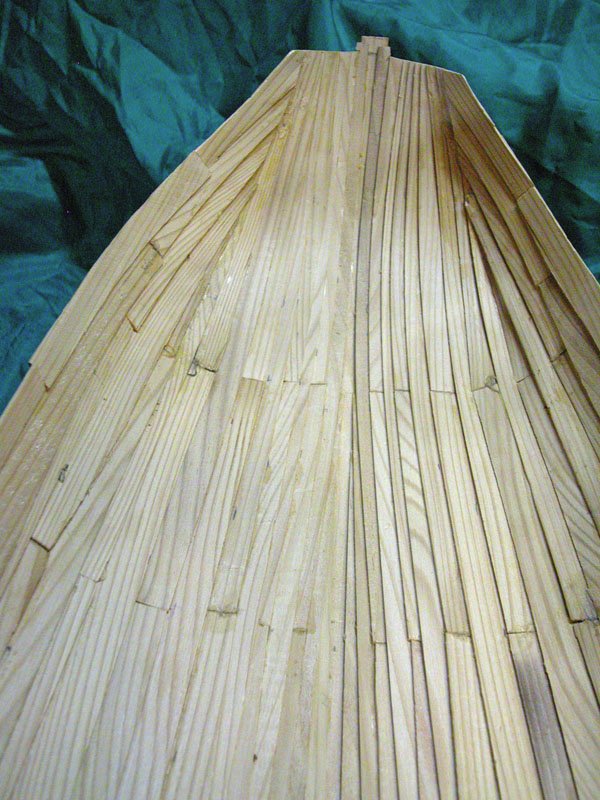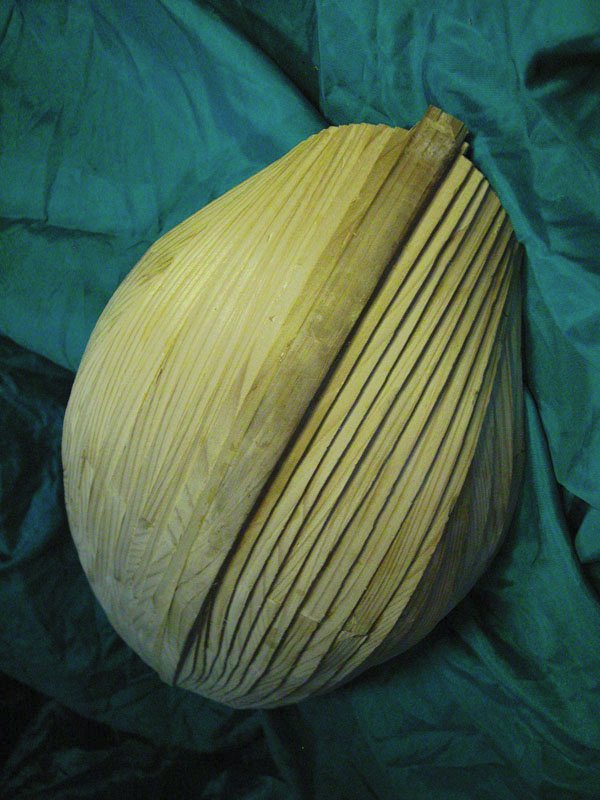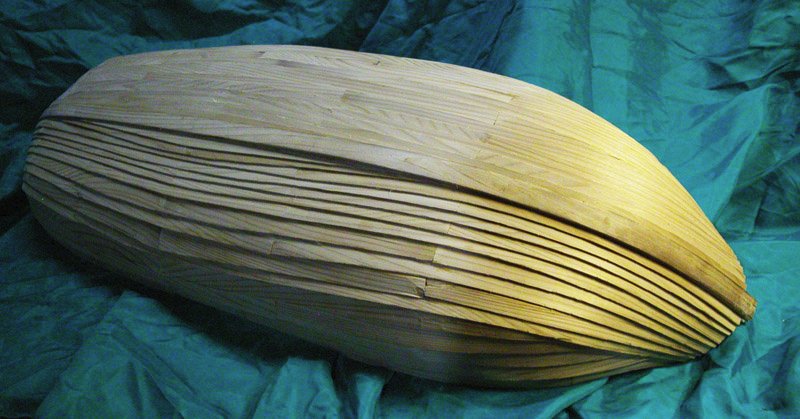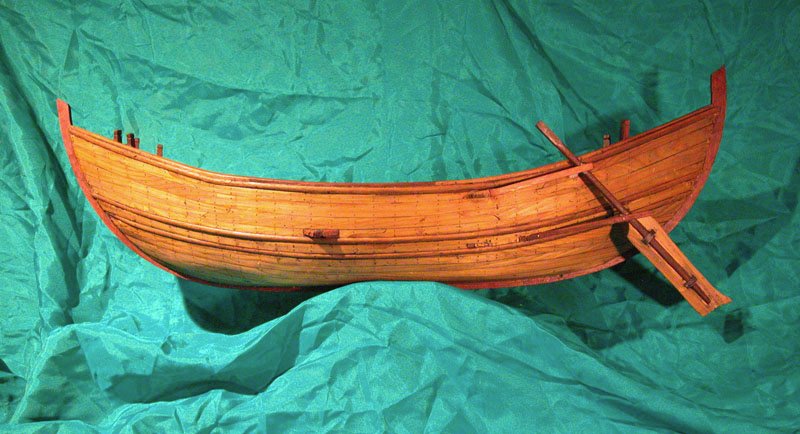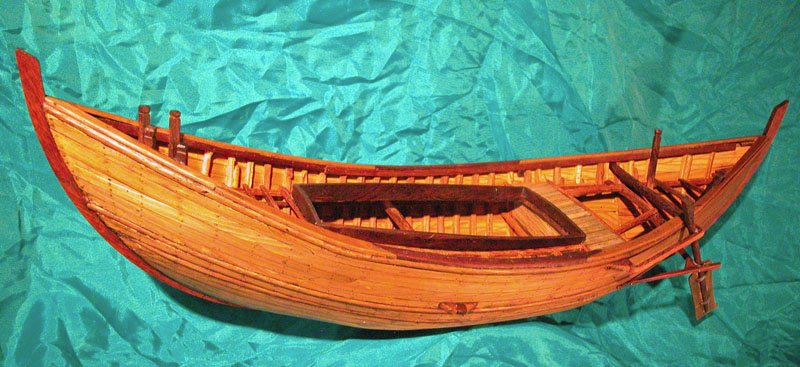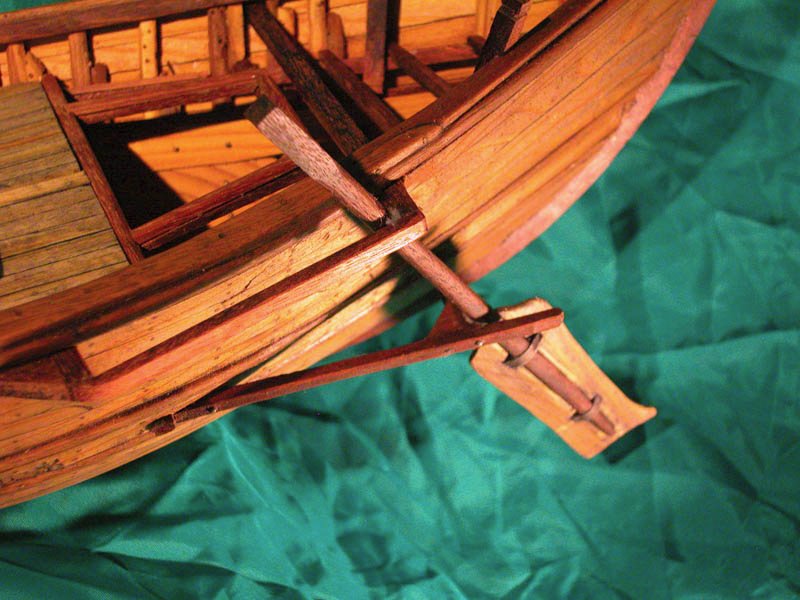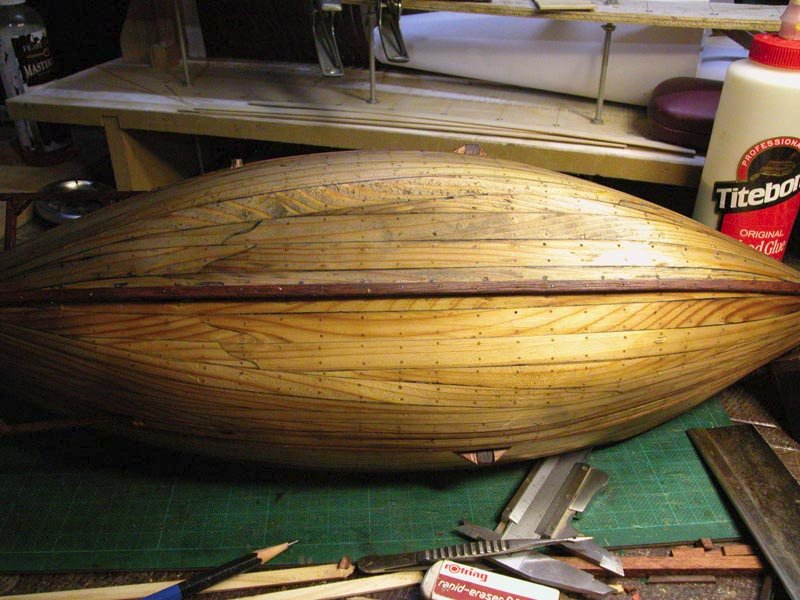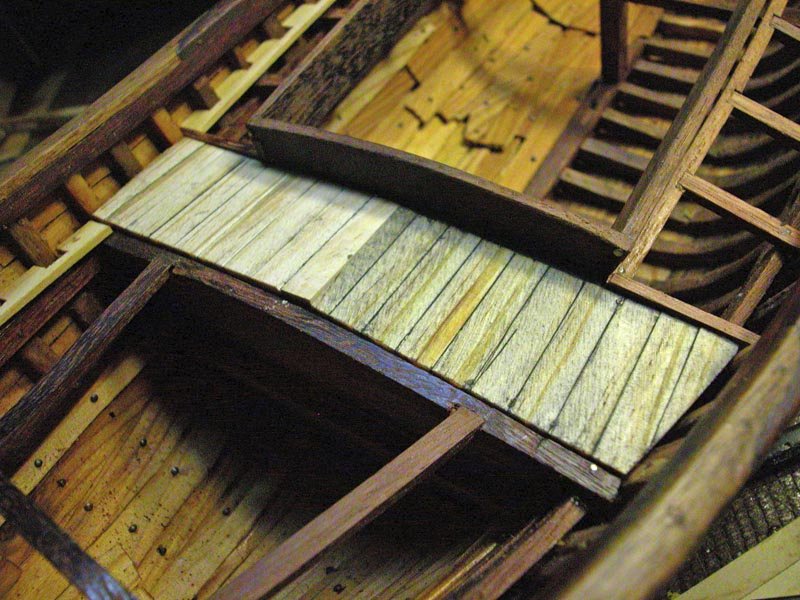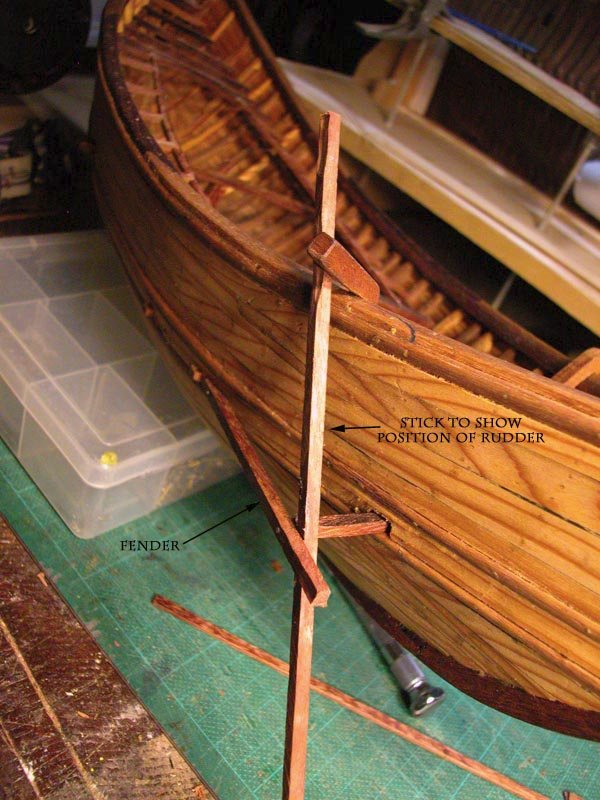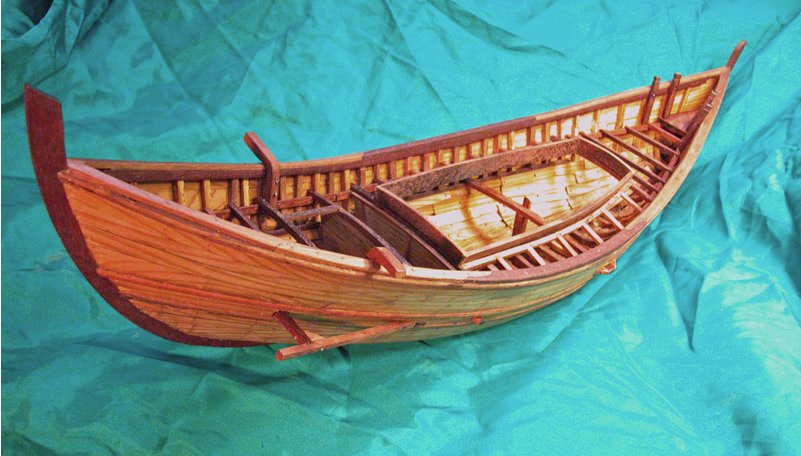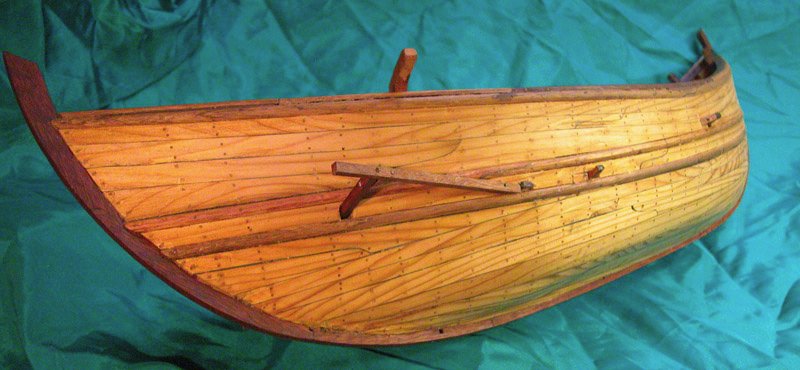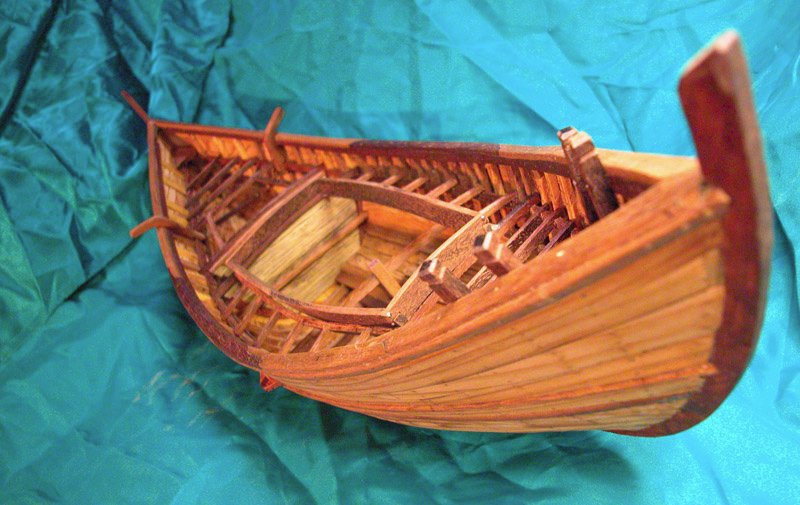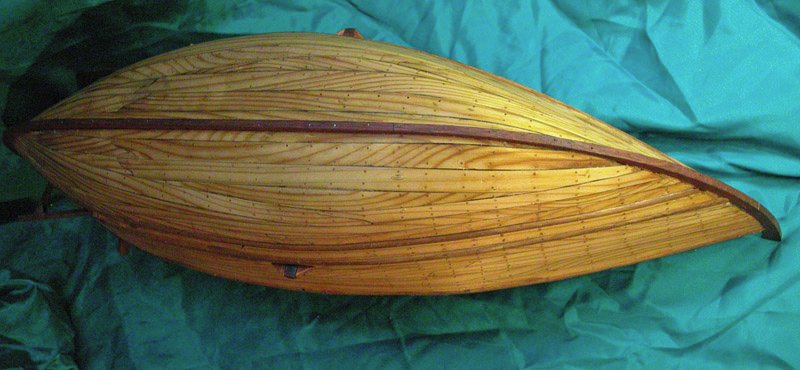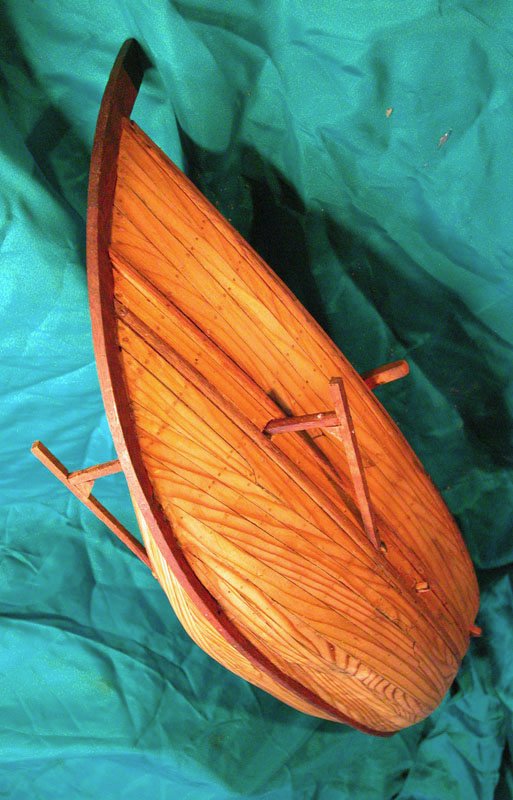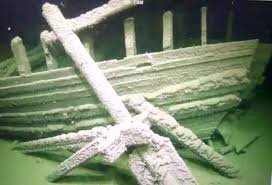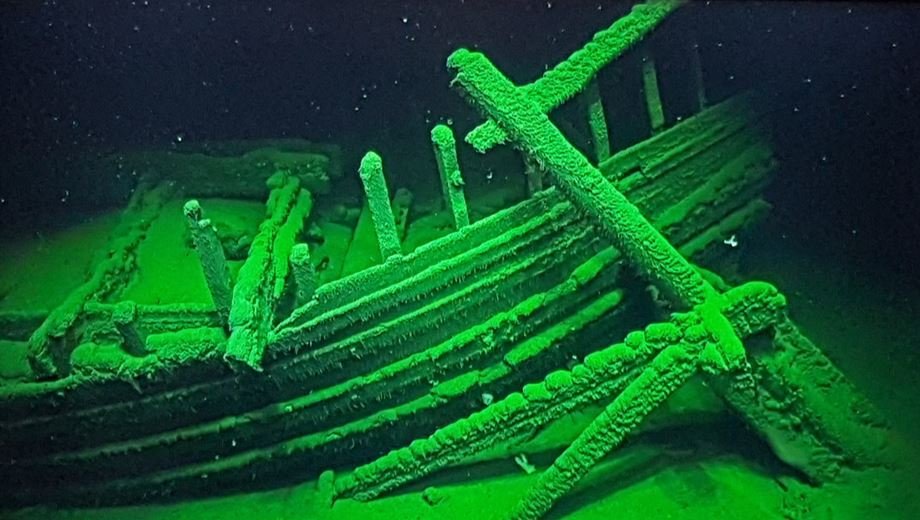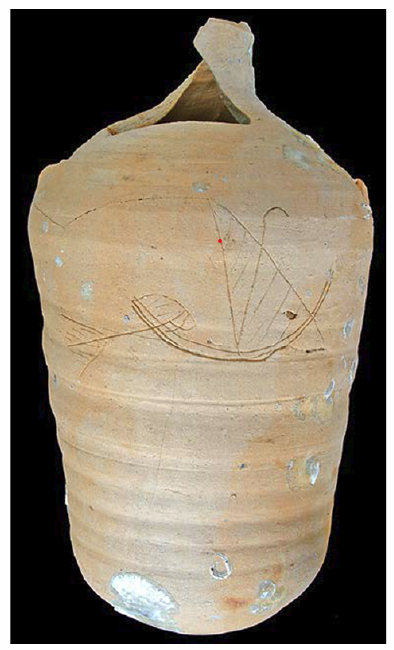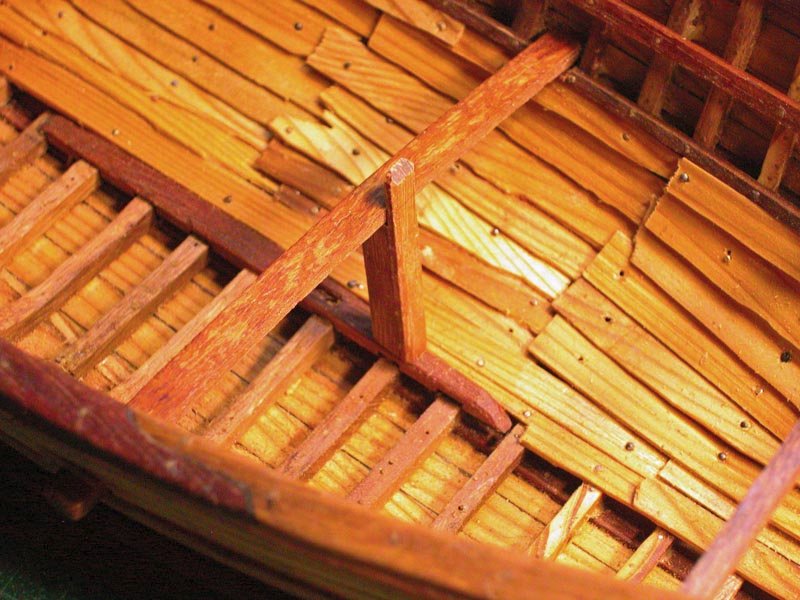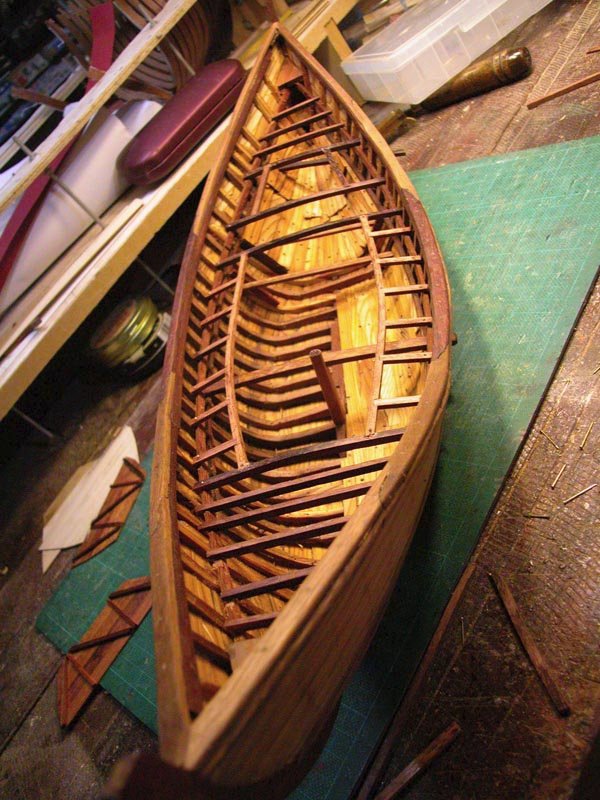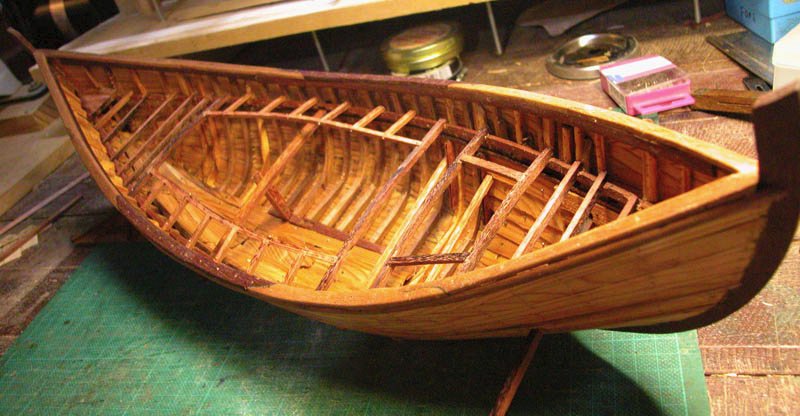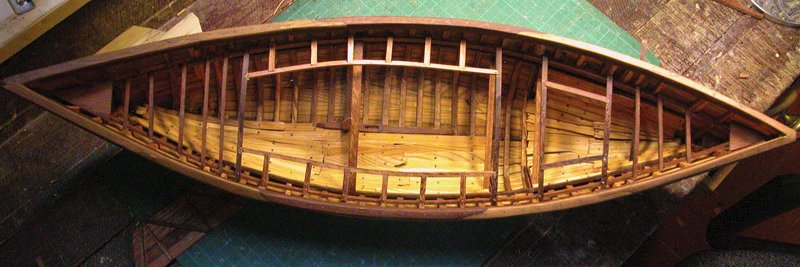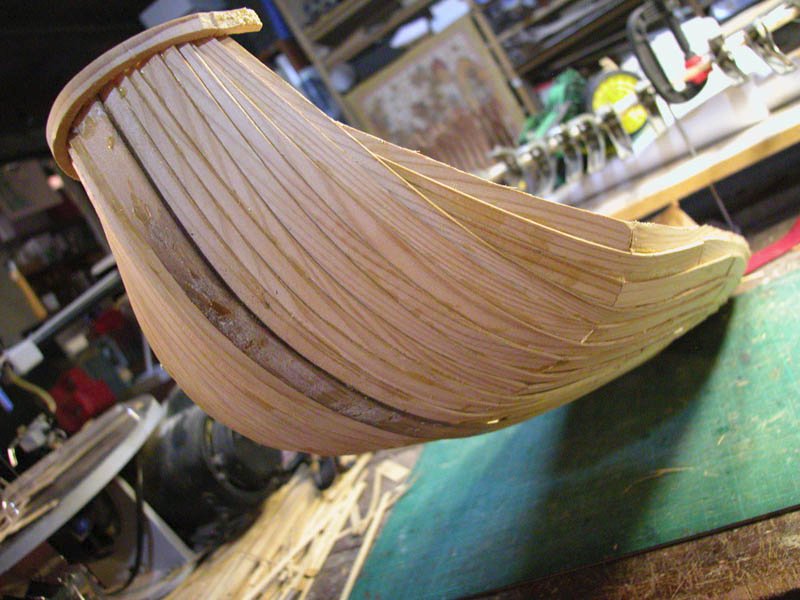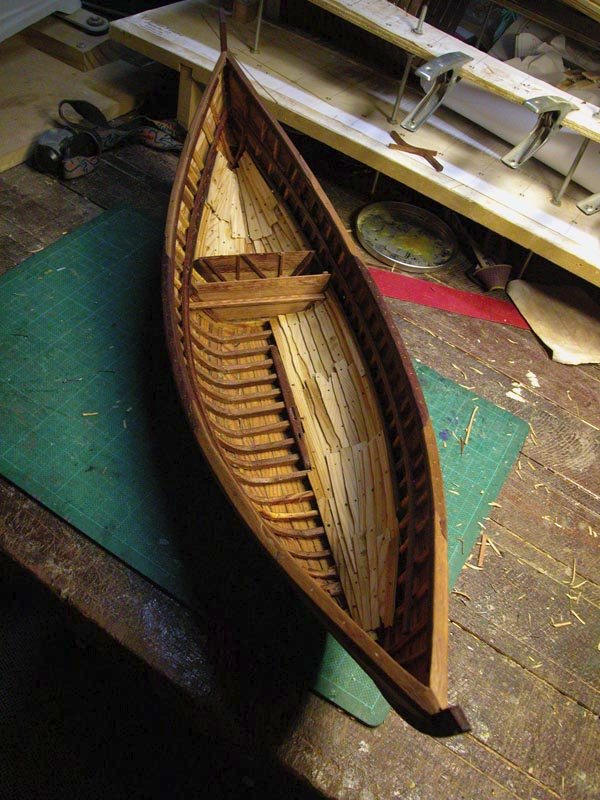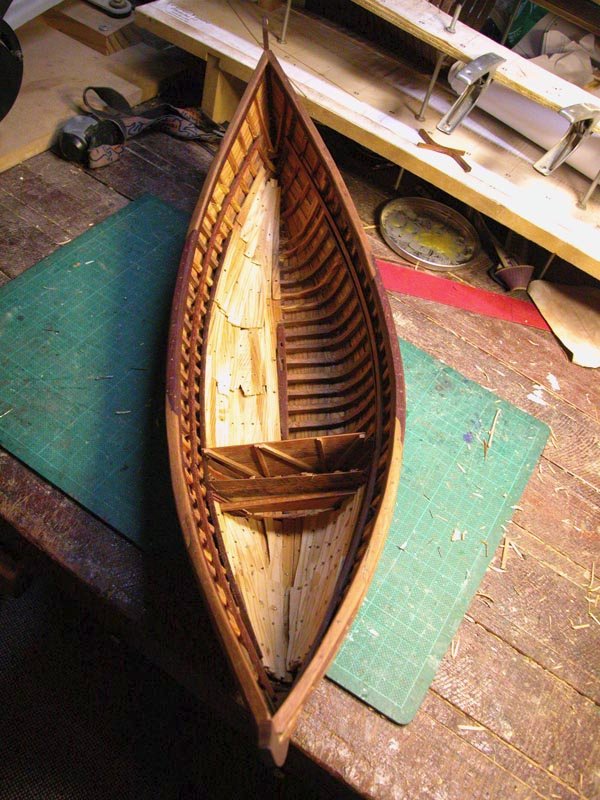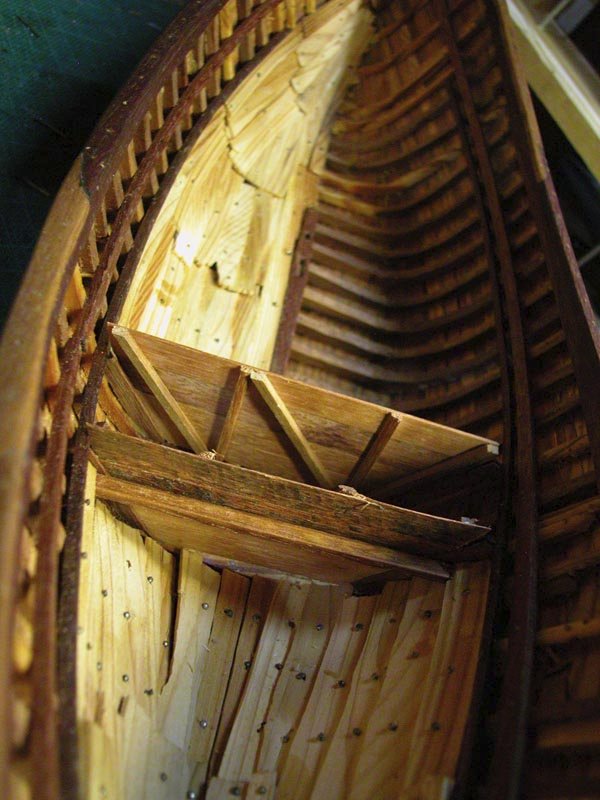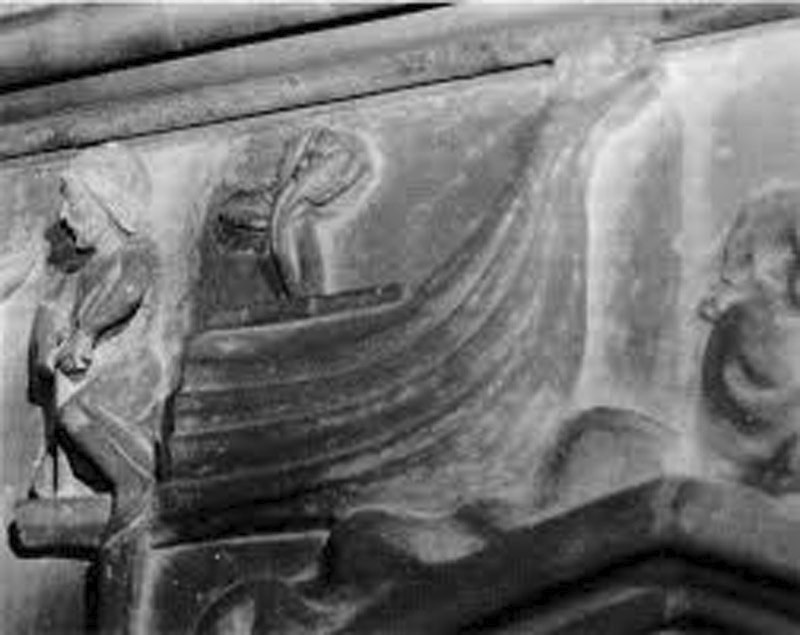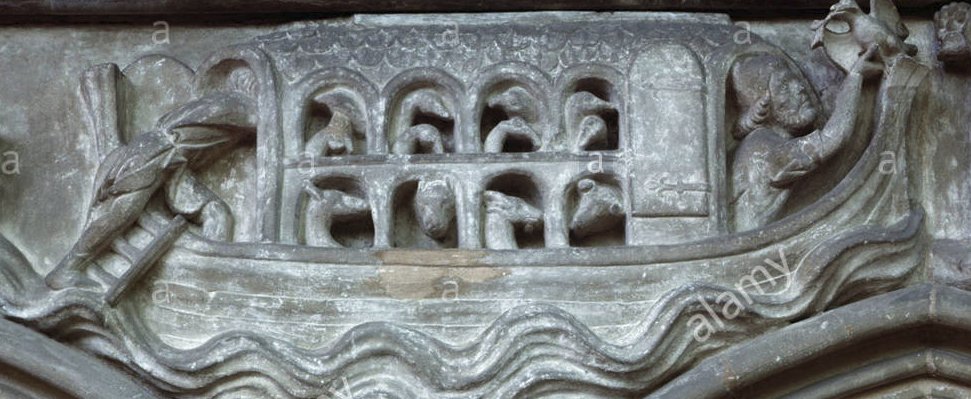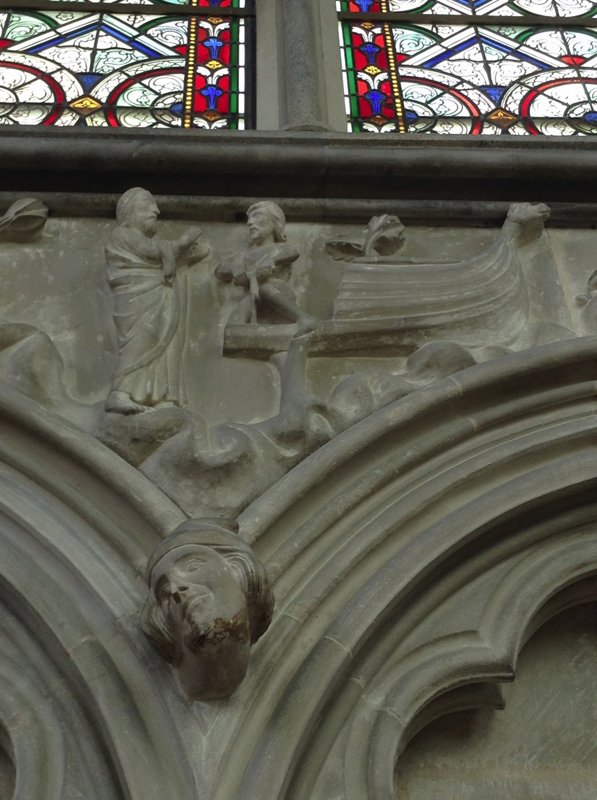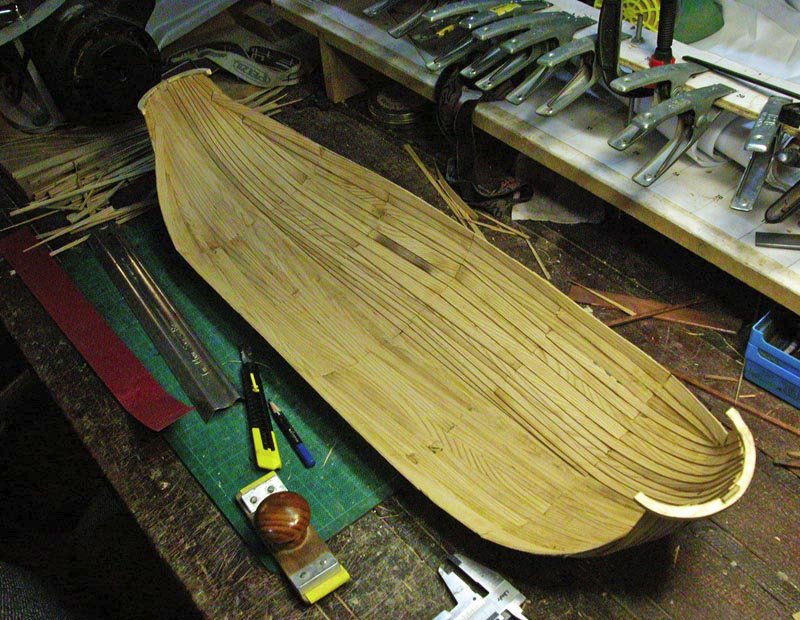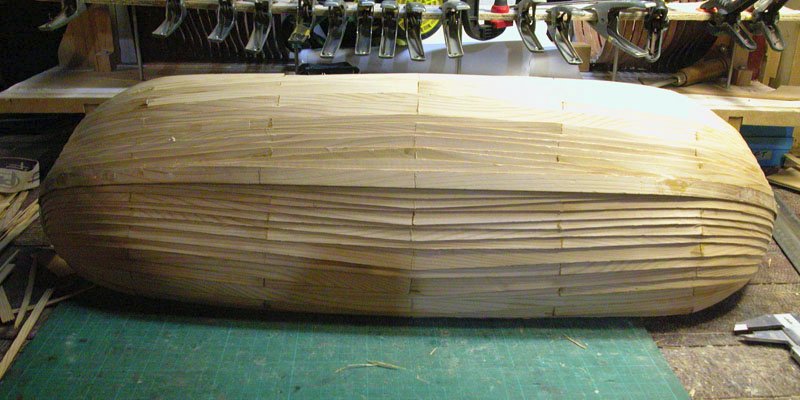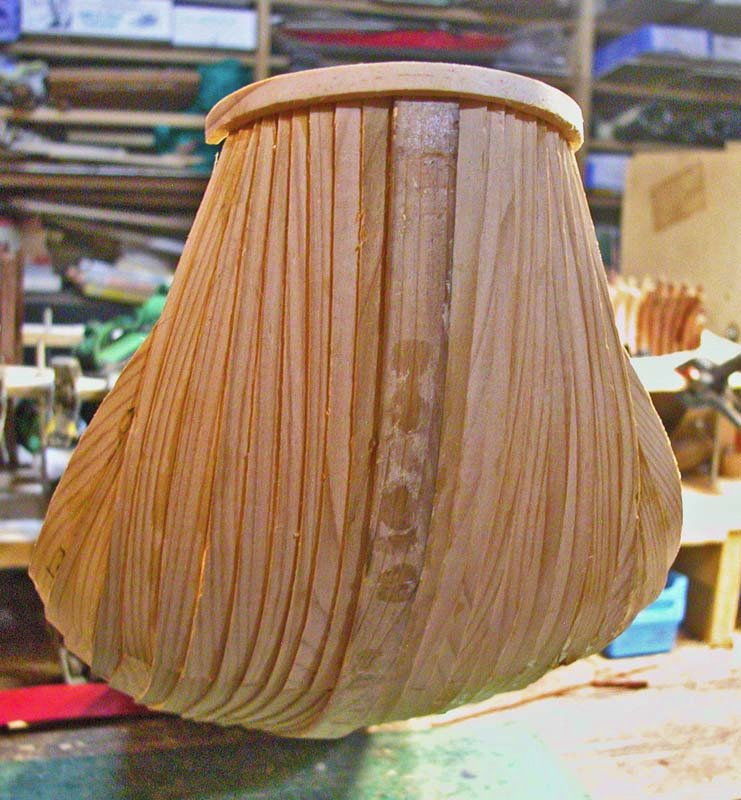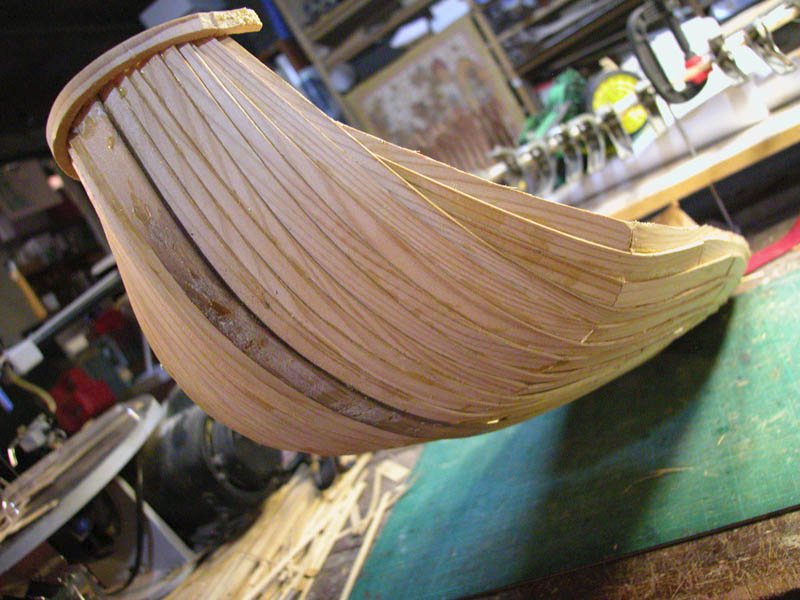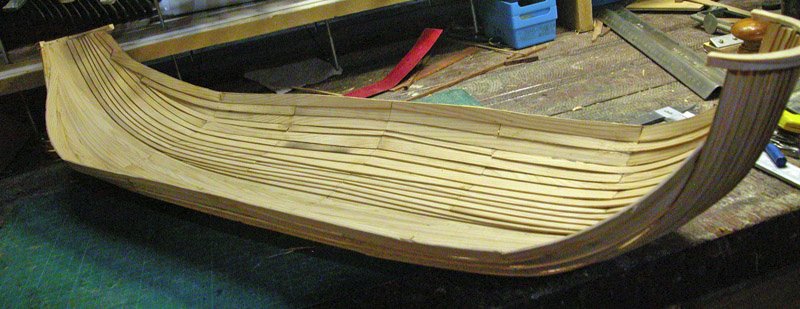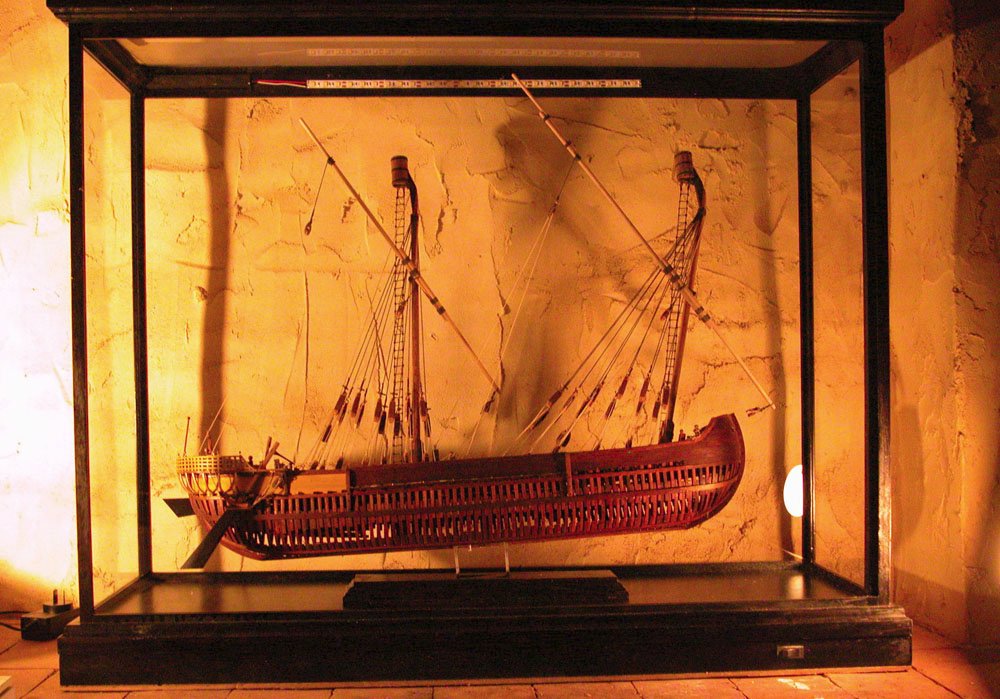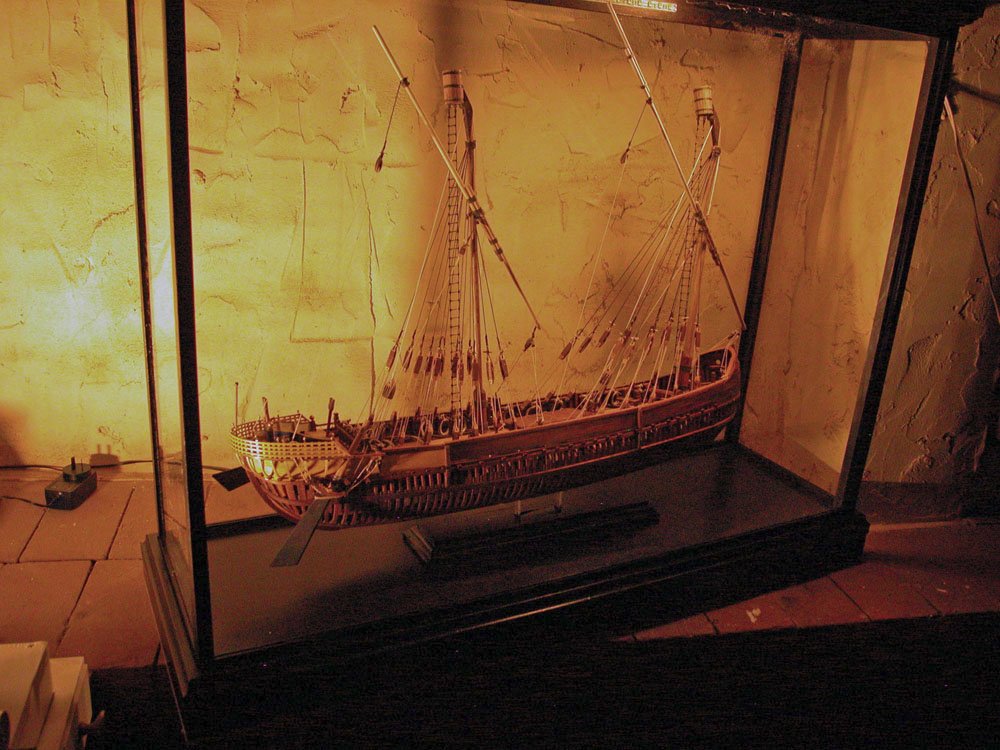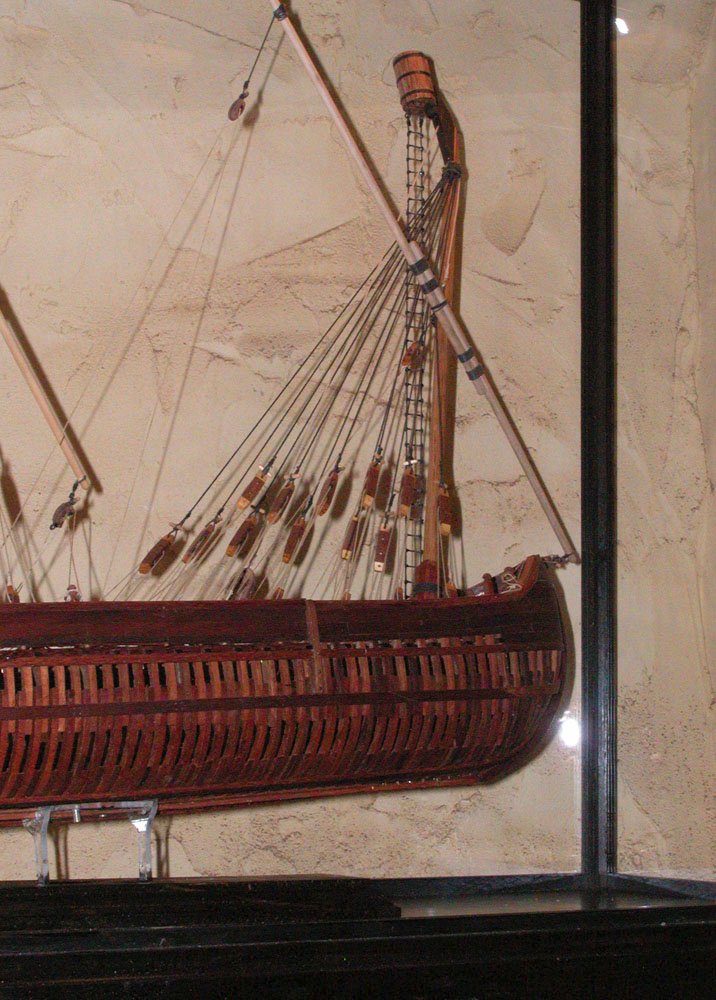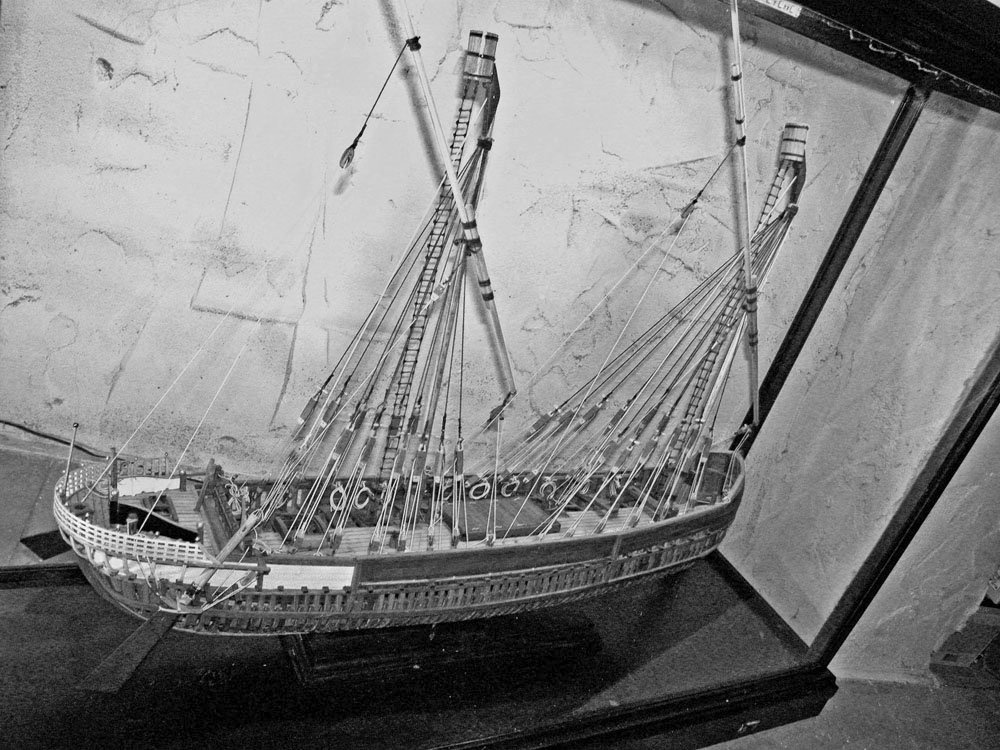-
Posts
835 -
Joined
-
Last visited
Content Type
Profiles
Forums
Gallery
Events
Everything posted by woodrat
-
The way I have done it, the only contact the halyard has is with the pulley and the peg at the tip of the hockey stick. The channel in which it travels is straight. Otherwise the halyard would wear out rapidly. Maybe a second pulley or rotating peg at the tip ?? Still thinking. Dick
-
Louie da Fly will like this. I have come up with a possible explanation for the strange "hockey stick" structure at the top of masts of byzantine and venetian vessels. It is a pulley for the halyard but, after going through the pulley, the halyard is conducted forward to the tip of the hockey stick so as to pull the yard away from the mast. This makes it easier to raise and lower the yard. This shows the mast in its step and lashed temporarily to the throughbeam and its stanchion. Cheers Dick
-
Having made the shell, the question was: what type of framing? As this putative varmint was known to predate (and postdate) the cog and to derive from the low countries, it was thought safe to position it close to the nordic tradition. So, I have decided to base the framing and decks on the known wrecks the Suldelev 1 and 3. The Skuldelev 1 was a deep sea trader or knarr (knørr?) and was quite wide. It was a sea-going vessel and a reconstruction sailed around the world. It also was deep enough to transport horses (as seen in the Bayeux tapestry. This was judged to be a suitable model for the frumious varmint. So, how to make the floors. I presume these were made by eye and shaped to fit the clinker flooring. In order to do this I adapted and modified an analog plotter which I made to take lines of a half hull for my carrack. first attempt. This barge is going to hold a lot of bread! Cheers Dick
- 186 replies
-
- keelless
- reverse clinker
- (and 4 more)
-
Yes, in a way. This method without a keel gives quite a lot of strength longitudinally and mandates a somewhat shallower draught. This fits in with the theory that hulcs had their origin in the low countries and was fluvial. Hence the barge like appearance which was mentioned in connection with hulcs and which carried more cargo than cogs. The question is whether these were safe in the open ocean? It would roll like a bastard. The reverse clinker would also have made less leeway which would be handy in shallow waters and may lessen the need for lee-boards. Dick
- 186 replies
-
- keelless
- reverse clinker
- (and 4 more)
-
I'm back and have had some fun finishing the planking of the hulc's shell. It is strong enough in longitudinal and lateral stress but has no resistance to torque until the cross members are installed. I have taken off the circular supporting timbers at the stem and stern and will replace them with something better. Some caulking, sanding and later oiling to be done. I DO like the lines, slinky-like but chunky. I think the next thing will be nailing of the planks to give it that extra reverse-clinky hulcy feel, pet. Cheers Dick
- 186 replies
-
- keelless
- reverse clinker
- (and 4 more)
-
The quarter rudders are made and temporarily fitted to a brace mount with guides. Note the blade is symmetrical and flat in cross-section whereas later quarter rudders were assymetrical and foill shaped in cross-section. This type of rudder is closer to the Graeco-roman than the mediaeval. Note the reinforcing lashings which are seen on later roman empire bas-reliefs. Merry Xams Dick
-
What a great display............... It should go straight to the pool room. Merry Xmas Dick
-
I have slightly darkened the vessel with a mixture of leather shoe wax and boot polish to a weather-beaten and pitch stained look. In this picture half the hull has been so treated. This has also been used to give a weathered look to deck planks. The wax is also useful to fill in any gaps which would have been caulked with pitch. Merry Xmas Dick
-
The deck framing and cargo hatch frame completed. It is my contention that the throughbeam for the quarter-rudder would have projected quite a lot to allow the rudder to be vertical. This would have rendered the beam and rudder to be vulnerable to impact and , a solution to this, a "fender" would have been necessary. I have installed this as well as smaller triangular fenders (seen on some illustrations of nefs from the middle ages) on the throughbeam for the mast. This looks a bit similar to the "wings" seen on the quarters of byzantine galleys and other vessels. The fender also resists the resultant lateral force from the rudder which a simple lashing will not do. I think this also shown in this Black Sea wreck of the roman era Cheers Dick
-
Yes I will do this. Particularly as an amphora found at the Yenikapi site has a graffito scratched on it showing a boat a bit like the Y 12 and showing a "hockey stick" at the top of the mast The hockey stick is a mechanism whereby the halyard is directed far forward of the mast such that, on loosening the yard from the mast, it falls forward away from the mast to allow rapid elevation or lowering of the yard. Interestingly, when the Y12 replica was built, they did not include a hockey stick, so it's up to me, I suppose. I also disagree with their interpretation of the quarter rudders. But more of that anon. Cheers Dick
-
The deck framing is in place as well as the throughbeam which supports the mast. a stanchion supports the throughbeam and buttresses the forward tilted mast. The rig will be lateen so the mast is forward tilted. Cheerio Dick
-
Basil designed this "hulc" out of his own head using his knowledge of extant patias of Bangldesh. There is no archaeological evidence yet of reverse clinker in the North apart from occasional scraps of futtocks and disputed wrecks which are probably clinker. Doing this hull is a good exercise and increases my knowledge of clinker hulls which will be useful in future builds . It will also make a great bread barge. Cheers Dick
- 186 replies
-
- keelless
- reverse clinker
- (and 4 more)
-
This a drawing from Basil Greenhill's book "The Evolution of the Wooden Ship" 1988. I have not been able to produce such an abrupt upward curve in the upper strakes fore and aft. So I have chosen this method:
- 186 replies
-
- keelless
- reverse clinker
- (and 4 more)
-
I don't really have any skills in that area. Wouldn't that mean coating the hull in pitch? I saw a scandinavian model using a pitch coloured decking oil. Haven't found that yet in the hardware store.
-
The ceiling planks are fitted but I left one side off in the cargo section to show the frames. The planks are clearly reused planks and rough as they would be regularly replaced with whatever was lying around the boatyard. This shows the removable bulheads in slotted boards. These are up against through beams to prevent amphorae shifting into the crew area. Cheerio Dick
-
They are a bit reluctant to supply methylene chloride because of its toxicity so they usually sell other glues to the general public. That's my experience. BUt you can get it if you go to the bulk supplier in your town. They also have these cute squeezy bottles with a needle on it that lets you run the stuff into the join. Worth a try. A couple of boards joined at an exact right angle and positioned like a V will support the sheets while applying the liquid methylene chloride. Dick
-
Thanks, PietFriet. Wise words. I think a little break from the build is needed. There is still enjoyment and, having reviewed all my images, there is enough there to justify a reverse clinker model. A frieze from the Chapter house of Salisbury Cathedral showing noahs ark dated to 1230 CE. Undoubtedly this shows reverse clinker and the sculptor has taken trouble to be accurate. Dick🙂
- 186 replies
-
- keelless
- reverse clinker
- (and 4 more)
-
I find myself at a crossroads and I dont know which way the Snark has gone. If I go down the present path I am committed to a long build of a putative vessel using vague assumptions and no hard data. The other path is to shelve the hull and complete my other projects. At the end of the day is this reconstruction TOO frumious to continue. What value is this build to anyone but me and the Bellman?😕 Dick
- 186 replies
-
- keelless
- reverse clinker
- (and 4 more)
-
I have completed planking up to deck level and taken the hull off its stand. The hull is seen to be quite barge-like which I believe the hulc was , if it existed, and betrays its probable fluvial origin. Obviously there would be a tendency to leeway and lee boards are not fitted. One of the advantages of reverse-clinker, it is said, is the resistance to leeway given by the horizontally directed plank edges . It is also said that the same feature minimises the amount of heeling in a cross sea. Perhaps the sailors can tell me if this is all cods. The hull is very light but quite strong even without rivets, which I will fit soon. Floors and cross members will add tranverse strength and hopefully prevent twisting or hogging. rivets, Cheers Dick
- 186 replies
-
- keelless
- reverse clinker
- (and 4 more)
-
Steven, The proper adhesive for polycarbonate is, I believe, methylene chhloride. This a bit toxic and you have to hold the sheets in jigs and run the liquid along the seam with a needle and syringe. This will actually fuse the sheets together. Superglue will produce clouding at the join. I elected to put he polycarbonate in slotted wooden frames which means they can be replaced if scratched. This is the third large case I have done this way ( see my round ship build, last page). Also see this link: https://www.cutplasticsheeting.co.uk/blog/uncategorized/how-to-glue-polycarbonate/
-
Thank you all at MSW for your help and support during this build. Cheers Dick
- 263 replies
-
- nave tonda
- round ship
-
(and 2 more)
Tagged with:
-
- 263 replies
-
- nave tonda
- round ship
-
(and 2 more)
Tagged with:
About us
Modelshipworld - Advancing Ship Modeling through Research
SSL Secured
Your security is important for us so this Website is SSL-Secured
NRG Mailing Address
Nautical Research Guild
237 South Lincoln Street
Westmont IL, 60559-1917
Model Ship World ® and the MSW logo are Registered Trademarks, and belong to the Nautical Research Guild (United States Patent and Trademark Office: No. 6,929,264 & No. 6,929,274, registered Dec. 20, 2022)
Helpful Links
About the NRG
If you enjoy building ship models that are historically accurate as well as beautiful, then The Nautical Research Guild (NRG) is just right for you.
The Guild is a non-profit educational organization whose mission is to “Advance Ship Modeling Through Research”. We provide support to our members in their efforts to raise the quality of their model ships.
The Nautical Research Guild has published our world-renowned quarterly magazine, The Nautical Research Journal, since 1955. The pages of the Journal are full of articles by accomplished ship modelers who show you how they create those exquisite details on their models, and by maritime historians who show you the correct details to build. The Journal is available in both print and digital editions. Go to the NRG web site (www.thenrg.org) to download a complimentary digital copy of the Journal. The NRG also publishes plan sets, books and compilations of back issues of the Journal and the former Ships in Scale and Model Ship Builder magazines.




